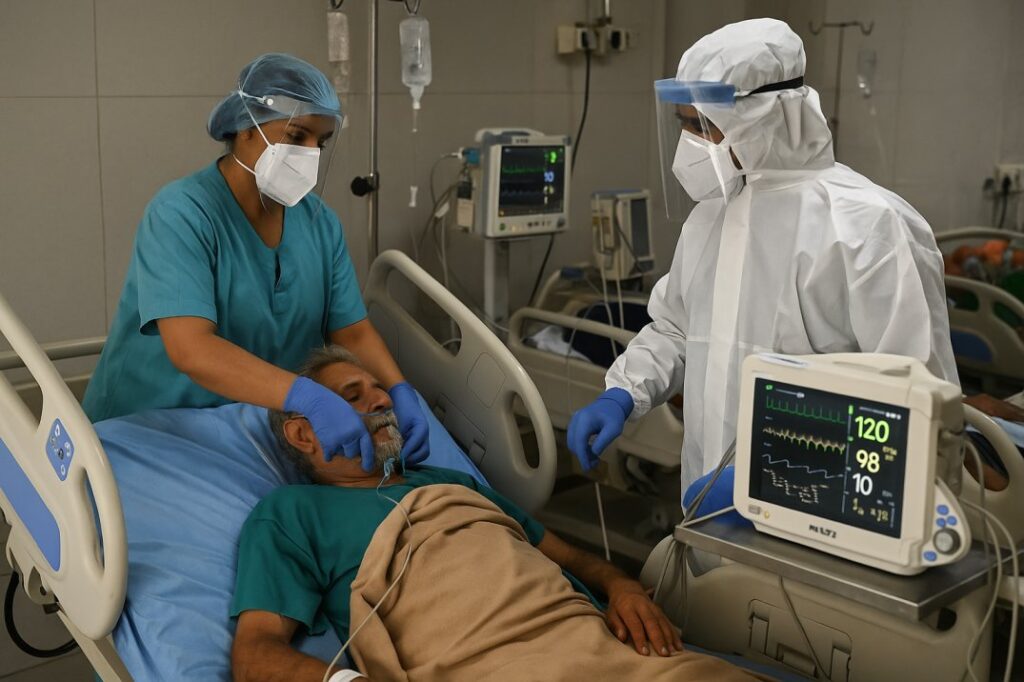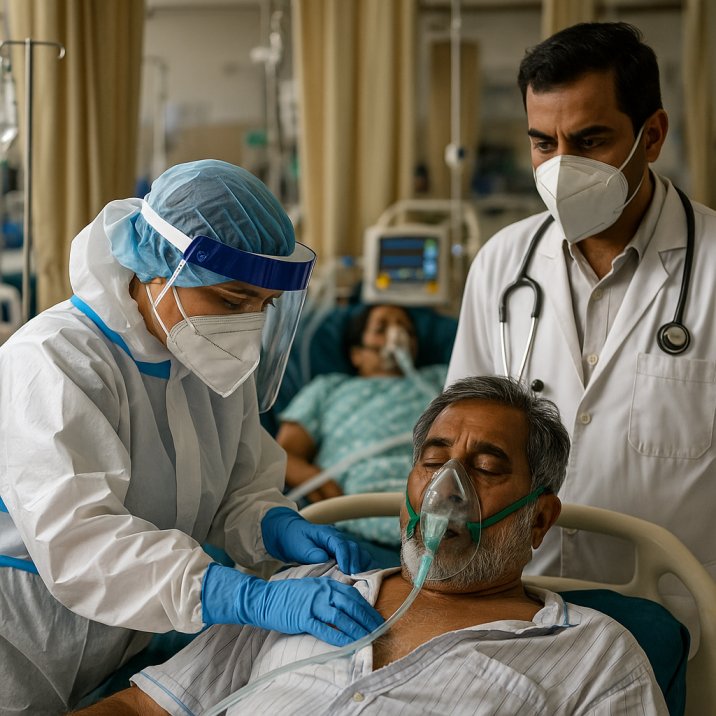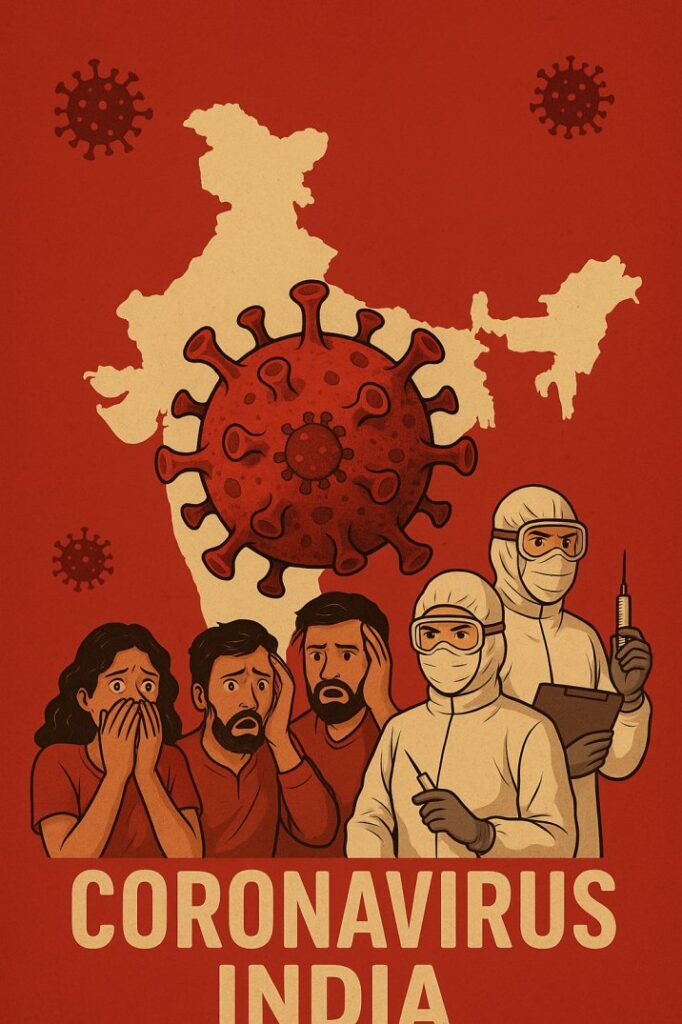Singapore COVID-19 Cases Surge: Implications for India in 2025

As of May 2025, Singapore has reported a significant 28% increase in COVID-19 cases, raising concerns across Southeast Asia. India, while currently maintaining a low active caseload, is closely monitoring the situation to preempt any potential resurgence.
India in 2025: Hyper-Vigilance Meets Hybrid Immunity
The Rise of “Forever Precautions”
India post-COVID strategy leans on permanent infrastructure built during the pandemic. By 2025, expect:

- AI-Powered Health Surveillance: TraceTogether tokens evolve into wearable devices monitoring flu-like symptoms, air quality, and even mental health trends.
- Vaccine Mandates 2.0: Annual mRNA boosters target newer variants, required for school enrollment, work visas, and public event access.
- Migrant Worker Reforms: Dormitories redesigned with better ventilation and healthcare access, partly funded by a new ASEAN migrant labor pact.
Understanding the Surge: Singapore’s COVID-19 Situation
In the week ending May 3, 2025, Singapore’s Ministry of Health reported approximately 14,200 COVID-19 cases, up from 11,100 the previous week—a 28% increase. Hospital admissions also rose by about 30%, although ICU cases remained low, decreasing from three to two daily cases. Ministry of Health+6nationthailand+6www.ndtv.com+6Study IQ Education+2India Today+2Ministry of Health+2
This surge is primarily attributed to the emergence of the JN.1 variant, a sublineage of Omicron. The variant’s increased transmissibility and potential for immune evasion have prompted health authorities to reinforce preventive measures.
India’s Current COVID-19 Landscape

India has reported 164 new COVID-19 cases between May 12 and May 19, 2025, bringing the total active cases to 257. The majority of these cases are concentrated in Kerala (69), Maharashtra (44), and Tamil Nadu (34). www.ndtv.com+5Business Standard+5Hindustan Times+5Indiatimes+1www.ndtv.com+1
Despite the uptick, most cases are mild, with no significant increase in hospitalizations. Health authorities, including the DGHS, ICMR, and NCDC, have convened to assess preparedness and emphasize monitoring of influenza-like illnesses and severe acute respiratory infections.
Comparative Analysis: Singapore and India
| Metric | Singapore (Week Ending May 3, 2025) | India (As of May 19, 2025) |
|---|---|---|
| New Weekly Cases | 14,200 | 164 |
| Total Active Cases | Data Not Specified | 257 |
| Hospital Admissions Increase | ~30% | No Significant Change |
| ICU Admissions | Decreased from 3 to 2 daily cases | No Significant Change |
| Dominant Variant | JN.1 | JN.1 |
India in 2025: Decentralized Health Systems and Vaccine Diplomacy
From Crisis to Global Health Leader
India’s catastrophic 2021 wave forced long-term reforms. By 2025:
- Primary Healthcare Revolution: 150,000+ Ayushman Bharat clinics now serve rural areas, equipped with telemedicine tools and rapid-test kits.
- Vaccine Maitri 2.0: India produces 60% of the world’s COVID-19 vaccines, including heat-stable nasal sprays for tropical regions.
- Oxygen Grids: A national network ensures emergency oxygen supply, inspired by 2021’s shortages.
📈 Projected India COVID-19 Stats (2025):
- Avg. Monthly Cases: 10,000–20,000 (concentrated in low-vaccination states)
- Vaccination Rate: 85% with at least one booster
- Key Challenge: Misinformation undermining booster uptake in rural regions.
Lingering Threats: What Could Derail Progress by 2025?
1. Variant X: A hypothetical evade-resistant strain could bypass hybrid immunity, reigniting lockdown debates.
2. Climate Change: Rising temperatures may expand mosquito-borne diseases (e.g., dengue), diverting COVID-19 resources.
3. Vaccine Nationalism: Stockpiling by wealthy nations during a scare could strain India’s export-driven model.
The Human Cost: Stories from 2025
Singapore: “We’re Safe, But Are We Kind?”
Rajesh Kumar, a construction worker from Tamil Nadu, shares: “My Singapore employer pays for boosters, but my family in India can’t afford them. The gap feels wider now.”
India: “Our Village Doctor Is Our Hero”
In Bihar, nurse Asha Patel uses WhatsApp to teach villagers about boosters. “They trust me more than politicians,” she laughs.
3 Lessons the World Can Learn by 2025
- Equity Is Efficiency: Nations that share vaccines, data, and tech fare better against variants.
- Local Voices Matter: Grassroots health workers (like India’s ASHA) are critical for trust.
- Prepare for the Unknown: Singapore’s “Disease X” taskforce now models outbreaks 10 years ahead.
Cross-Border Collaboration: Singapore and India’s 2025 Health Alliance
The “Pan-Asian Pandemic Pact”
In 2023, Singapore and India co-founded a regional alliance to combat future outbreaks. By 2025, this pact has:
- Shared Genome Sequencing Databases: Faster detection of variants in Indian states or Singaporean dormitories.
- Joint Vaccine R&D: Bharat Biotech and Singapore’s Arcturus Therapeutics collaborate on a universal coronavirus vaccine.
- Travel Corridor 2.0: A digital health passport mutual recognition system, allowing quarantine-free travel for vaccinated citizens.
💡 Impact: Trade between the two nations grew 22% post-pact, with Singapore investing $1.5B in India’s healthcare startups.
Conclusion
Singapore’s recent surge in COVID-19 cases highlights the ever-present risk of new variants and the importance of sustained vigilance. India’s current situation remains under control, but the developments in neighboring countries serve as a reminder that the pandemic is not over. Continued public health efforts and community cooperation are essential in navigating this phase.
Your Turn:
- How should nations balance vigilance with normalcy?
- Could another pandemic unite—or divide—the Global South and North?
Join the conversation below. For deeper insights, explore our analysis on Climate Change and Health Crises.
Visual Elements Suggested:
- Infographic: “Timeline to 2025: Singapore & India’s Health Tech Milestones”
- Image: A futuristic clinic in rural India with a Singaporean flag outside (AI-generated concept).
- Chart: Projected vaccine production vs. demand in Southeast Asia (2025).
CTA: *“Want more future-focused insights? Download our free 2025 Global Health Report or subscribe for weekly updates!”*

